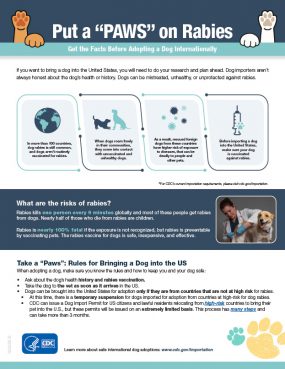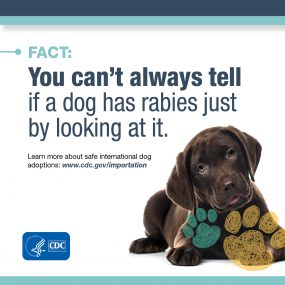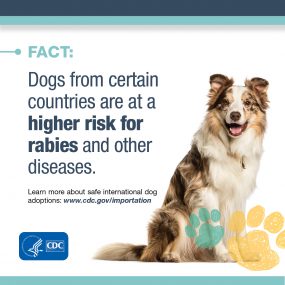International Dog Adoptions: Get the Facts
World Rabies Day, a global health observance started by CDC and the Global Alliance for Rabies Control, is September 28. Help us “Put a PAWS on Rabies” by vaccinating your pets against rabies and opting for safe and ethical pet adoption. Learn more about rabies and safe pet adoption.
Dogs offer their owners many benefits, including more opportunities for exercise and socialization and even improved health, but it’s important to do your research before adopting a dog, especially if you are adopting from overseas. Some overseas adoption agencies may be scams or misrepresent the dog’s health and medical history. Get the facts before you adopt to ensure that you and your dog stay safe and healthy!
Risks of Adopting Dogs from Overseas
Scams
Some dog importers may be imposters. Organizations such as rescue groups, animal welfare agencies, or even private breeders may misrepresent themselves and the dogs they sell, rescue, or adopt. Some people who have adopted puppies from overseas did not receive the dogs they thought they were getting, and in some cases haven’t even received a dog, after sending full payment. If you’re thinking of adopting or purchasing a dog from overseas, it’s important to learn the ways that importers might try to fool you:
- Sending a different age, sex, color, or breed of dog than the one promised
- Telling fake stories about the dog’s background (for example, telling you the dog was rescued from a meat market when the dog was bred for sale)
- Sending photos of dogs that are different than the one they ship
- Misrepresenting the dog’s health and sending falsified health or vaccination records with the dog
It’s important to ask the importer detailed questions about the dog and its history. You have a right to ask and to understand where the dog came from and its health status. Learn how to spot common scams:
- Internet Adoption Scams Involving Imported Pets
- Puppy Scams: How Fake Online Pet Sellers Steal from Unsuspecting Pet Buyers [PDF – 10 pages]
- International Pet and Animal Transportation Association: Pet Scams
Inhumane treatment
Before adopting a dog, be sure to research the organization, visit the organization in person if possible, or read reviews and ask if you can speak to previous clients to ensure the organization is transparent about animal health and welfare. Many unethical organizations raise dogs in inhumane conditions to make money on adoptions. Puppy mills operating overseas may falsely advertise as being US-based. These dogs are often taken away from their mothers too early and raised in poor, overcrowded conditions, which puts them at higher risk for many diseases. The puppies are subjected to very long, uncomfortable flights in the cargo hold when they are unfit to travel, and some puppies don’t survive the trip. Often, dogs imported to the United States become sick within days of arrival, leading to unexpected, expensive veterinary bills for families who just spent a lot of money to bring the dog into the country.
Disease

Dog rabies is still common in more than 100 countries. In many of these countries, dogs aren’t routinely vaccinated for rabies. Dogs often roam freely in their communities and come into contact with unvaccinated and unhealthy dogs. As a result, these dogs are more likely to be exposed to diseases, including rabies, that can be deadly to people, dogs, and other animals.
In addition to rabies, dogs can carry bacteria, viruses, and parasites that can make people very sick, especially young children. Diseases that can cause illness in dogs or be spread by dogs include:
- Salmonella infection, which can cause serious illness in children younger than 5 years old, adults 65 years and older, and people with weakened immune systems.
- Campylobacteriosis, which can cause diarrhea in people and dogs and can cause serious illness in children younger than 5 years old, adults 65 years and older, and people with weakened immune systems.

Parasites and parasitic diseases such as fleas, ticks, New World screwworms, hookworms, roundworms, and Giardia, which can infect dogs and cause disease in people.
- Leishmaniasis is a parasitic infection spread by sand flies on the hair of animals, in crates and on bedding. Signs of leishmaniasis in dogs include hair loss and weight loss. In people, leishmaniasis can leave disfiguring scars or cause organ failure.
- Leptospirosis, a bacterial disease that affects people and dogs. Signs of disease in both people and animals can include fever and vomiting, and occasionally kidney or liver failure.
- Skin infections such as MRSA, a type of drug-resistant bacteria, known to be contagious between people and dogs.
- Brucellosis, a bacterial disease that can cause infertility, abortions, and infections of reproductive organs in dogs. It can also cause recurring fever and organ infections in people.
Dogs can also carry other infectious diseases that can make other animals sick.
- New strains of flu, resulting in outbreaks in animal populations.
- Foot-and-mouth disease and African swine fever, which do not infect dogs or humans, but are a serious threat to US livestock. These viruses can spread through dogs’ fur as well as bedding, crates, and other surfaces that can be brought into the United States with an imported dog.
Risk of Rabies
Rabies is a deadly but preventable viral disease that kills one person every nine minutes globally, nearly half of whom are children. It can spread to people and pets if they are bitten or scratched by an animal with rabies, even if the animal has no symptoms. The United States eliminated dog rabies in 2007 and now rabies in the US is mostly found in wild animals, but even one dog infected with rabies poses a risk of reintroduction in the US.
Rabies Facts
- Rabies is preventable. Vaccinating dogs against rabies protects dogs, other pets, and people. The rabies vaccine for dogs is safe, inexpensive, and effective.
- You can’t tell if a dog has rabies by just looking at it. Rabies signs can vary greatly; some dogs may appear aggressive while others may act sleepy. You can get rabies from a dog even if the dog has no signs of rabies.
- Dogs from outside the US can have rabies. Dog rabies remains common in many countries. When adopting a dog from overseas, be sure you know where the dog is from and its history because health records, including rabies vaccination certificates, can be fraudulent.
- Even puppies can get rabies. Puppies are susceptible to rabies because they can’t get vaccinated to protect them from rabies until they are three months old. People can get rabies if they are bitten, licked, or scratched by a dog (or puppy) with rabies.
- Rabies is deadly for dogs and other animals. Rabies is deadly for people too when they don’t receive immediate care, called post-exposure prophylaxis (PEP). Because PEP can be costly and time consuming (it includes an antibody treatment and four doses of vaccine for healthy, unvaccinated individuals), vaccinating dogs for rabies is the best way to prevent rabies in people and dogs.
If you are bitten or scratched by an unfamiliar dog (including a dog recently brought into the US from another country), contact a healthcare provider to determine your risk for rabies or other illnesses.
Bringing a Dog into the United States

You can help ensure safe, ethical adoptions and purchases
CDC regulates the importation of dogs into the United States to protect the health of people, their pets, and wildlife. You can help protect dogs, other animals, and people by ensuring your dog adoption or purchase is safe and ethical.
Consider adopting in the United States. Local adoption can be easier, quicker, cheaper, and safer for you and your dog. In US shelters, the dog will receive required vaccines and parasite treatment before coming home with you, and you will be confident that the dog you are bringing home is the one you chose.
Talk to your veterinarian about the risks of adopting dogs from overseas to make an informed decision.
If you do decide to adopt or purchase from overseas, make sure you do the following:
-
Take your dog to the vet as soon as it arrives. No matter where you get a new dog from, you should always take it to the vet as soon as you can so you can establish a relationship with your veterinarian, get necessary vaccines and medications, and get the dog screened for possible health issues.
- Vaccinate your dogs for rabies. The best way to prevent rabies in people and pets is to vaccinate dogs. The rabies vaccine for dogs is safe, inexpensive, and effective. Rabies vaccination of dogs is required by law in most states. Since foreign vaccination may not use a USDA-licensed vaccine, consider revaccinating your new dog right away.

Know how to recognize the signs of rabies and other dog illnesses and look out for them during the first six months you own your new dog. If your dog shows signs of illness, take them to the vet and be sure to tell your vet that your dog was adopted from overseas. Other countries have different disease risks than the United States. Talking with your vet about your dog’s overseas adoption will help your vet consider diseases that may not be present in the US. If people in your household show symptoms of these illnesses, visit your healthcare provider.
- If you adopt from overseas, make sure you know the steps required to import a dog into the United States. Make sure you set aside plenty of time for the required paperwork and testing. Given the significant public health and animal health risks, any dogs that aren’t compliant with US requirements will be shipped back to their country of departure at your expense, resulting in increased stress for you and your new pet.
Bringing dogs into the United States

There is a temporary suspension of dogs entering the United States from countries with a high risk of dog rabies. Follow the rules at www.cdc.gov/DogTravel to determine what you must do to bring a dog into the United States.
If you do not follow CDC’s rules, your dog will not be allowed to enter the United States. Your dog will be returned to the country of departure at your expense.
- CDC Rabies
- CDC: Bringing an Animal into the United States
- CDC Healthy Pets, Healthy People: Dogs
- Need to Know: Rabies in Pets – YouTube: Learn more about rabies risk in imported dogs
- Global Alliance for Rabies Control (GARC): Learn how GARC is working to eliminate human deaths from dog rabies by 2030.
- GARC: World Rabies Day: Learn about rabies facts and myths, the global issues affecting rabies elimination, and get resources to promote World Rabies Day.
- United Against Rabies: Watch videos from the 2020 United Against Rabies Forum which included speakers and experts from across the world working to eliminate rabies.
- End Rabies Now: Learn about the challenges and solutions for ending rabies globally by 2030.
- USDA Animal and Plant Health Inspection Service – Pet Travel: USDA and state requirements for importing and exporting dogs and cats
Have you researched the organization or read reviews? Do you know anyone else who adopted a dog from this organization?
That’s good! Be sure to read reviews and/or ask clients about their experience and whether the organization treated them fairly, followed all importation rules, and informed clients of the process and steps to import dogs.
You should research the organization before agreeing to adopt a dog from them. Be sure to read reviews about the organization and consider asking the organization if you can speak to previous clients to ensure they are transparent and put animal health, safety, and welfare first.
Will the organization allow you to speak with previous clients?
This is a good sign. Ask previous clients about their experience and whether the organization treated them fairly, followed all importation rules, and informed clients of the process and steps to import dogs.
This is not a good sign. Ask additional questions and consider choosing another organization that will be more transparent with information.
Do they have a US address?
This could be false advertising. You need more information. Try to find a local organization near you that you can visit in person to meet the dogs, tour the facility, and get to know the organization through face-to-face interactions.
Proceed cautiously. They could be a legitimate adoption agency, but you need more information.
Is the seller or organization located in a country with a high risk of rabies?
Dogs from these countries must meet additional requirements for entry into the United States during the current suspension.
Proceed cautiously. If your dog is shipped to the United States and does not meet entry requirements, it will be returned to the country of departure at your expense.
Have you been asked to pay any money up front?
You should proceed cautiously as many adoption scams require payment prior to shipping the dog, but then never follow through.
Good! Any organization or individual that asks for money before you receive the dog may be scamming you. Shopping locally for a dog is the best way to protect yourself and ensure you get the dog you paid for.
Have you seen a photo of the dog?
Proceed cautiously. They could be a legitimate adoption agency, but you need more information. Try to find a local organization near you that you can visit in person to meet the dogs, tour the facility, and get to know the organization through face-to-face interactions.
Ask for a photo of the dog and information about the dog’s health. If the organization is not transparent with this information, consider doing additional research on the organization or choosing a new organization.
Does the organization provide details about the dog’s health history and rabies vaccination?
This is a good sign, but you should still take your dog to the vet when it arrives in the United States to ensure it’s in good health and to establish a relationship with your veterinarian. Be sure to let your veterinarian know where your dog came from.
Be careful, this is a bad sign. Rabies vaccination is recommended for all dogs entering the United States, and it is required if the dog is coming from a country with a high rabies risk.
Do you know how old the dog that you are adopting is?
A dog should be at least eight weeks old before it is separated from the mother. Puppies must be at least six months old to enter the United States if they are arriving from or have visited a country with a high risk of dog rabies.
A dog should be at least eight weeks old before it is separated from the mother. Puppies must be at least six months old to enter the United States if they are arriving from or have visited a country with a high risk of dog rabies.




